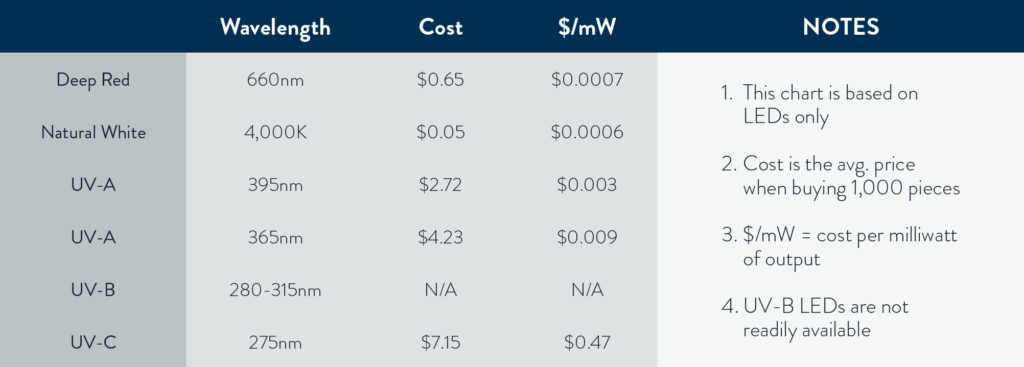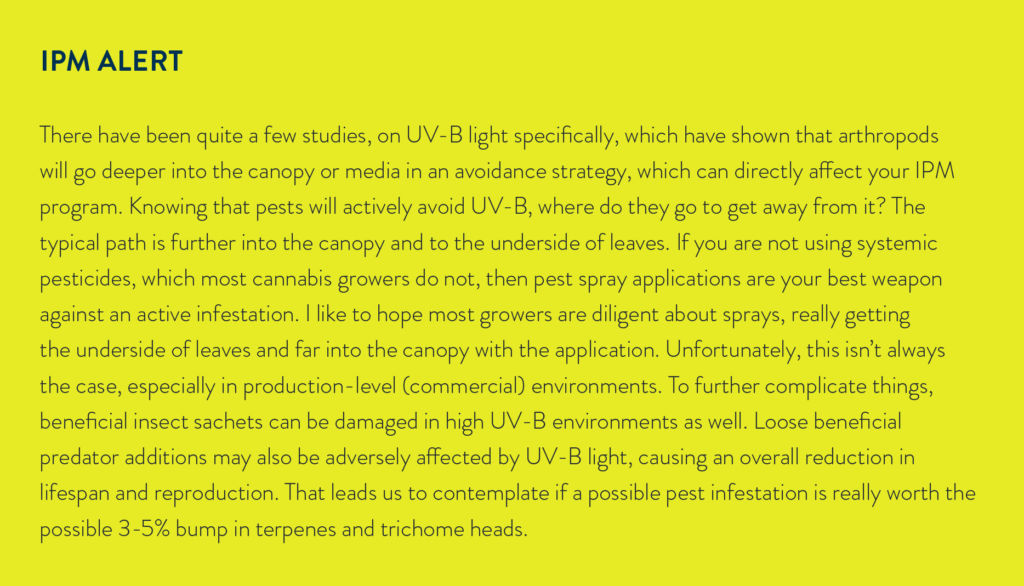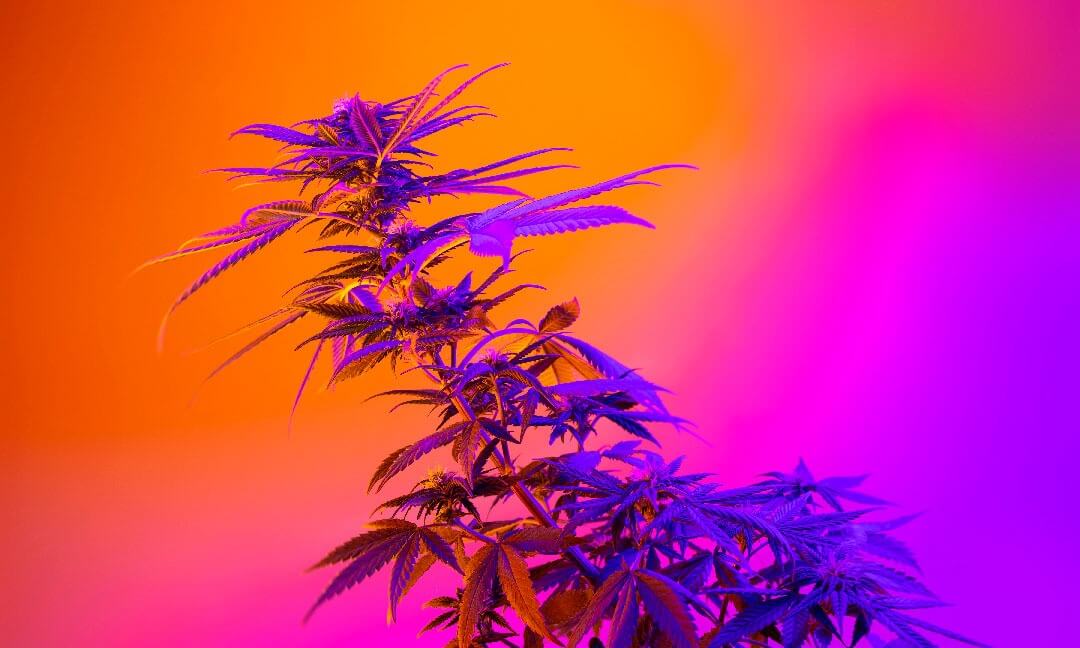What is the true UV and Cannabis relation? There are few more heated topics in the cannabis industry than the potential of UV light to improve the quality of cannabis plants. Some growers insist that it is an undeniable fact that UV is necessary to grow high quality cannabis, period. The demonstrable data to date, however, is minimal at best. While there have been a handful of good studies conducted on UV light and cannabis, on the whole, their results are inconclusive and unremarkable.
This begs the question, “Why are so many cannabis growers certain that they need UV to achieve that ‘fire’ bud?” The answer lies in a scientific exploration of UV light and how it influences plant morphology. All light consists of particles traveling in waves, and the distance between them, or the wavelength, determine the light’s properties. UV wavelengths cover a range of 100-400 nanometers (nm). UV-A light, at 315-400nm, has the longest wavelengths of the group. At 280-315nm, UV-B has shorter wavelengths and UV-C has the shortest at 100 – 280nm. In nature, plants encounter mostly UV-A and some UV-B. UV-C wavelengths, being so short, are mostly absorbed by the atmosphere and rarely make it to the ground.
The first question is, “Why is there such an industry wide belief that UV light is needed in the first place?” When plants of any type encounter UV, they produce stress responses that trigger protection mechanisms. Just as humans use sunscreen to protect themselves from the harmful rays of the sun (UV-A and UV-B), plants produce secondary compounds like anythrocynine to protect themselves from these same damaging UV wavelengths.
As cannabis growers, many of us find this response alluring. On the surface, the concept of more purples and secondary compounds such as anythrocynine seem likely to lead to a better terpene and cannabinoid suite in our final product. The science, however, indicates that UV and Cannabis relation effects are minimal at best. Yes, we get more vibrant colors and possibly better trichome head production as well. Ironically though, it seems this can also be achieved with any full spectrum LED on the market without the extra stressor of UV light. As the scientific studies are lacking here, anecdotal stories and results are all that we can rely on today.
The Claims on UV and Cannabis relation
The claims surrounding UV are widespread enough that it is worth exploring some of them. Of highest interest is the idea that UV-A and UV-B contribute to an increased production of THC in the plant. Science, fundamentally, still hasn’t come to any conclusions on this. Some strains, like OG landrace crosses and cannabis strains from traditionally high-UV areas around the globe have shown some bumps in THC production and secondary cannabinoids. Hemp CBD cultivars, on the other hand, have shown increases in secondary compound production. Overall, today’s indoor, exotic, multiple-cross cultivars have shown no great response to the introduction of UV as a minor stressor. As breeding moves further away from natural outdoor genetics, the added UV can actually cause negative effects for plants that have never been exposed to these types or levels of stressors.
Another claim is that UV-A and UV-B produce more trichomes and more complete heads on the trichomes, creating a frostier looking flower. The jury is still out on this one. Current research into this is in its beginning stages and most of the work so far has been done on hemp. Personally, in my time working with growers around the country, I have heard many stories about better returns on washing hash when UV-A or UV-B was introduced during the grow cycle. Again, there is little hard evidence to these claims though. What this could mean is that we are seeing better structure from our trichomes, just maybe not more of them.
As our research into cannabis continues, we hope to see more data come out of future experiments. Bruce Bugbee has a project underway looking very closely at cannabis’ response to UV-A and UV-B and the UV and Cannabis relation. In a recent interview, shedding some light on his current work, he suggested some of the early research from heavy blues (400-450nm), just short of the UV-A spectrum, were showing similarly beneficial effects.
An additional question we must ask is why are we not seeing more LED light manufacturers adding UV to the fixtures? With UV-A being 50-100x the cost of a full spectrum white or even a deep red LED, the cost for UV is definitely prohibitive. For a manufacturer to include this in every light they sell, it gives pause and begs the question of its validity and value. Especially as we look at commercial facilities who are purchasing hundreds of lights, is there enough evidence (as of the publishing of this article there is not) to support the increased cost?

Some studies are starting to look into the UV and Cannabis relation and show that UV-A (365nm) and UV-B in small doses or cycles are what really trigger photomorphogenesis within plants, especially cannabis. If these results are proven true, it would mean that UV should not be built-in to LED fixtures unless they have control over it through spectrum tuning or channel control. Interestingly, most LED fixtures on the market today that have UV built-in, have UV-A (395nm), which has yet to be shown any more effective than blue LEDs in the 400-450nm range. As a cautionary note, both UV-B and UV-C must be used with extreme caution around humans and it makes it virtually impossible to have either of these spectrums built-in to an everyday grow light.
Is UV Worthy of All The Hype?
Does this mean we should or shouldn’t invest in UV? Like any other choice you make as a grower, it completely depends on what you are looking to achieve within your grow and with your plants. Depending on your grow style, spending the extra money on a UV fixture may or may not get the result you’re looking for.
Let’s start with our hydroponic growers, which includes anyone with inert media or water based set-ups (since there are many different ways on how to work with coco coir, it is included both here and with the soil media). Hydro/salt growers should have complete control over the nutrients and uptake for their plants. This means they can accomplish a “dialed-in” setup, where ideal uptake and nutrient availability is achieved. Adding UV-A or UV-B to these very low stress environments is probably the most effective application. Anecdotally, we typically see a 3%-5% bump in overall quality (quality = increased terpenes/cannabinoids and/or bag appeal; typically not weight). It is worth emphasizing though that this only applies if you are reaching maximum output from your current setup before adding in UV.
Soil and organic coco coir growers have some secondary things to consider. First and foremost, multiple studies have shown UV-B can degrade organic additions. Bacteria and fungal communities can be impacted and have been shown to actively avoid high UV-B areas. Research also shows that arthropods will be pushed further into the canopy or media to avoid the high UV-B light (more on this later). Secondarily, ask yourself if you’re getting 100% out of your plants already. Is that 3-5% bump from minor stressors going to be worth compromising your additions?
These growers will probably tell you that the color structure and flavor are better than those produced with salts. Will the UV-A and UV-B be that golden key to the production you are already achieving? More times than not the answer to that will likely be no.

The Dangerous Side of UV
Finally, let’s touch on UV-C. This wavelength is mostly used in clean-lights and to purify air for indoor areas. It’s a great tool for cleaning and removing contaminants from a grow environment. It can be beneficial as a direct leaf application to control certain types of powdery mildew. It is important to note that the amount of tissue damage from UV-C on leaves and buds is not always worth the help, and long exposure to UV-C or UV-B has been shown to adversely affect plant tissue. It creates an almost burned look on buds and leaves an opening to a secondary invasion from pathogens.
Final Verdict on UV and Cannabis Relation
So, what’s the verdict on the UV and Cannabis relation? It depends! For starters, there has yet to be scientific proof that UV-A adds more value than deep blue (400-450nm) light. If you are growing for terpene or hash production in a hydroponic environment, it may very well be worth experimenting with blue (430nm), UV-A or UV-B to see how it might enhance quality. If you are an organic/soil grower, the addition of UV, given the positive and negative trade offs, may not bring enough value to introduce it into your grow. UV-C should be used in air cleaning devices yet left out of most grow environments, as the impacts on plants and humans alike keeps this in a do-not-use category.
At the end of the day there’s no free lunch and no silver bullet. UV-A, B and C have their advantages and value adds, but they all come at a cost. Just like most things in life, the overall cultivation strategy you employ requires a holistic approach with a defined goal in mind to maximize the outcomes. UV won’t magically change anything and may just be the type of disruption you are trying to avoid. Remember, the devil is truly in the details, especially when it comes to the UV and Cannabis relation.
Greg Selby
Director of Cultivations Sciences, Scynce LED
Specialist in IPM Strategies & Soil Ecology
REFERENCES:
G. Jenkins, The UV-B photoreceptor UVR8: from structure to physiology, Plant Cell 26 (2014) 21–37.
J. Moan, Visible light and UV radiation, in: A. Brune, R. Hellborg, B.R.R. Persson, R. Pääkkönen (Eds.), Radiation at Home, Outdoors and in the Workplace, Scandinavian Science Publisher, Oslo, 2001, pp. 69–85.
R. McKenzie, D. Smale, M. Kotkamp, Relationship between UVB and erythemally weighted radiation, Photochem. Photobiol. Sci. 3 (2004) 252–256.
B.A. Brown, L.R. Headland, G.I. Jenkins, UV-B action spectrum for UVR8-mediated HY5 transcript accumulation in Arabidopsis, Photochem. Photobiol. 85 (2009) 1147–1155.
J.J. Casal, Photoreceptor signaling networks in plant responses to shade, Annu. Rev. Plant Biol. 64 (2013) 403–427.
D.T. Krizek, Influence of PAR and UV-A in determining plant sensitivity and photomorphogenic responses to UV-B radiation, Photochem. Photobiol. 79 (2004) 307–315.
M. Götz, et al., PAR modulation of the UV-dependent levels of flavonoid metabolites in Arabidopsis thaliana (L.) Heynh. leaf rosettes: cumulative effects after a whole vegetative growth period, Protoplasma 243 (2010) 95–103
L.O. Morales, et al., Effects of solar UV-A and UV-B radiation on gene expression and phenolic accumulation in Betula pendula leaves, Tree Physiol. 30 (2010) 923–934.
L.O. Morales, et al., Temporal variation in epidermal flavonoids due to altered solar UV radiation is moderated by the leaf position in Betula pendula, Physiol. Plant. 143 (2011) 261–270.
P.W. Barnes, A.R. Kersting, S.D. Flint, W. Beyschlag, R.J. Ryel, Adjustments in epidermal UV-transmittance of leaves in sun-shade transitions, Physiol. Plant. 149 (2013) 200–213.
F. Martz, et al., Effects of ultraviolet (UV) exclusion on the seasonal concentration of photosynthetic and UV-screening pigments in Scots pine needles, Glob. Chang. Biol. 13 (2007) 252–265.


Thank you for your Study n your Knowledge. It is Really Helpful with my Decision on buying the right light ?